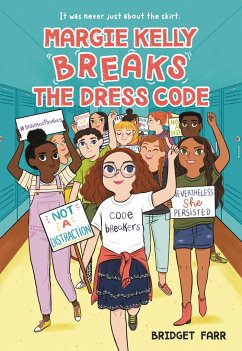

Although our dress code has since been updated with more inclusive standards, many schools continue to categorize clothing or hairstyles as “disruptive” based on a student’s gender expression or racial identity. While researching for my middle grade novel, Margie Kelly Breaks the Dress Code, I discovered that my own school district prohibited “skirts that distract,” a shockingly sexist and subjective standard. Most caregivers don’t read the dress code closely until they’ve received a call from the school office, but these unexamined rules often codify racism, sexism, and other long-held biases. Step 1: Review your school’s dress code: you might be surprised at what you find.

With school pictures, prom, and other clothing-focused school events coming this spring, here are four steps to understanding (and perhaps changing!) your school’s dress code. Students often perceive dress codes as out-of-touch, and frustrated caregivers may secretly wonder what message is being delivered when their child is told their skirt is distracting or their hoodie is menacing. For many parents, getting their child into a dress-code-compliant outfit is an unwelcome daily struggle.


 0 kommentar(er)
0 kommentar(er)
